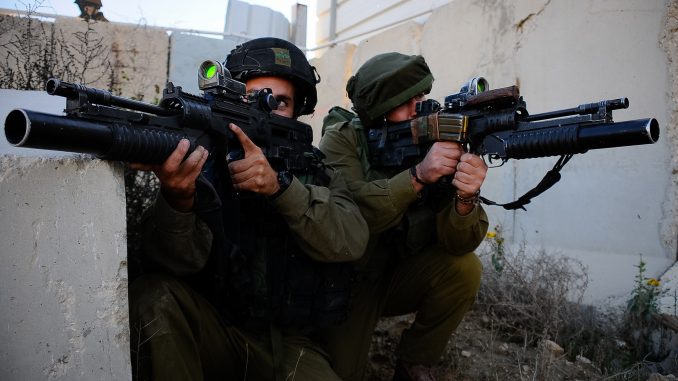BESA Center Perspectives Paper No. 570, August 26, 2017
By Yaakov Lappin

EXECUTIVE SUMMARY: Creating deterrence was Israel’s goal in the last three conflicts it fought against Hamas, but that objective has been cast aside. Any future armed clash with Gaza’s Islamist rulers will be guided by a new Israeli objective: that of achieving a crystal clear victory over the enemy.
In past models of conflict, Israel responded to Hamas aggression through the use of force in a way that was designed to punish Hamas and convince it to return to a state of calm. Systematically destroying Hamas’s military capabilities was not an Israeli objective.
Today, while Israel hopes to avoid war, it is preparing for the possibility of a new conflict. War could erupt again in Gaza for a wide range of reasons.
Should hostilities resume, the Israel Defense Force (IDF) plans to make sure the end stage of that clash will be an unmistakable Israeli victory, and that no one will be able to mistake it for a tie or stalemate.
This change in approach has been brewing over the past three years, ever since the end of Operation Protective Edge in 2014. That operation was launched by Israel to defend itself against large-scale projectile attacks and cross-border tunnel threats from Gaza. At two months’ duration, it was one of Israel’s most protracted conflicts.
It was also the third large-scale clash fought with Hamas since 2009. At the end of each round of fighting, the military wing of Hamas remained intact, and was able to quickly begin rearming and preparing new capabilities for the next outbreak of hostilities.
Should Hamas initiate another conflict with Israel, Jerusalem should not be expected to return to the deterrence model. It will not make do with the goal of returning calm to the area, as it did in 2014, 2012, and 2009.
Instead, Israel would likely seek to destroy Hamas’s military wing, including its underground labyrinth of tunnels under Gaza City, built to enable operations out of Israel’s sight.
Hamas’s decision to embed many of its offensive capabilities in Gaza’s civilian areas will not immunize it to Israeli strikes. The IDF would, however, make every effort to minimize harm to noncombatants.
After 2014, the IDF’s Southern Command began moving away from the “frequent rounds” model, concluding that Israel should not be dragged into major armed conflicts with Hamas every two to three years.
The Southern Command identified three alternatives for Israel and Gaza. Under the first, Israel would continue to experience short, temporary truces – an option deemed unacceptable.
In the second scenario, Israel would conquer Gaza and topple the Hamas regime completely. In such a scenario, Israel would either rule the Strip and its two million Palestinian inhabitants or find someone who would.
It is unlikely that the Palestinian Authority (PA) would take over Gaza after an Israeli “handoff.” Not only would the PA lose domestic legitimacy, but its ability to retain Gaza without IDF assistance would be in serious doubt.
As a result of these calculations, the defense establishment identified a long-term truce, fueled by Israeli deterrence, as the best option. That is the current situation between the combatants: a long-term truce.
During the time the truce has lasted, the idea of facing two bad choices – occupying Gaza or accepting the “frequent rounds” model – has evolved.
One possibility, in the event of a new conflict, is that the IDF takes out Hamas’s military wing but leaves in place its political wing and police force, thereby creating a feasible Israeli exit from Gaza that does not depend on Jerusalem’s finding new rulers for the Strip.
Today, three years after Operation Protective Edge, Hamas continues to rebuild itself. Its domestic arms industry is producing rockets, mortar shells, and tunnels. Tunnels under Gaza City are designed to enable Hamas battalions to launch hit-and-run attacks on the IDF and to move weapons and logistics out of Israel’s sight.
The other kind of tunnel threat, the network of cross-border tunnels, is on borrowed time. Israel is building an underground wall along the 65-kilometer Gazan border, and it progresses with each passing day. Israel has invested billions of shekels in that project, and an anti-tunnel detection system is also operational.
Hamas is not sitting idle during the truce. It is looking for new assault tactics. It seeks to be able to flood southern Israel with short-range projectiles that can carry a warhead as big as a half-ton, which would pose a major threat to any built-up area near the Strip.
Hamas can also try to paralyze central Israel with medium-range projectiles, even if these are intercepted by the Iron Dome air defense system. Air raid sirens and interceptions are severely disruptive for Israel even without significant projectile damage.
Hamas continues to work on its naval commando cells, which are designed to infiltrate Israel via the coast. It is also continuing to pursue its drone program, with which it hopes to send explosives at targets in a guided manner.
Israel is well aware of these capabilities. Hamas remains a serious combat challenge, and has proven its ability to adapt to Israel’s progress.
But Hamas is also under intense, unremitting Israeli intelligence surveillance. Hamas is likely aware that any new clash would involve upgraded Israeli combat capabilities that are better suited for the Gazan arena.
Israel has been using the truce to build up its force and study the Gazan battlefield. It is building a growing fleet of armored personnel carriers and tanks that can defend themselves with active protection systems. In Gaza, where practically every Hamas fighter is armed with an armor-piercing RPG, that kind of protection is a game changer.
Israel’s ability to strike Hamas’s underground city has also been enhanced significantly in recent years. Hamas will have nowhere to hide if war resumes. Hamas is likely aware that although it can pose serious challenges to the IDF and to the Israeli home front, Israel has changed its end game.
For the time being, Hamas’s cost benefit analysis has led it to conclude that a lengthy truce is in its own best interest.
Yaakov Lappin is a military correspondent and analyst. His areas of coverage are focused on Israel’s defense establishment, and the country’s strategic environment. Yaakov is also the Israel correspondent for Jane’s Defense Weekly and author of Virtual Caliphate: Exposing the Islamist State on the Internet.



How long would it take for Israel to destroy Hamas and Gaza if it flew in F16 & 15s in formations of 24. Each fighter jet can hit 10 different targets at the same time. So 240 hits at one time. At the same time hit them with naval and artillery fire. Israel now has perfectly accurate artillery missiles that can hit anywhere in Gaza. If Israel used this approach I would anticipate a route of Gaza within days not weeks.
Kill all Hamas and other terrorists visible. Rent Cruise Ships allow non terrorists to get on board and take these people to Libya or anywhere else someone will take them. Maybe Turkey, Tunisia, Morocco or Algeria or the Sudan want them.
ISRAEL wins battles not wars. only ISRAEL would still be fighting 67, 73. lesbenon, and gaza battles. do to the enemy as they declare their desire to do to you. nice guys finish last, first losers.
“The IDF would, however, make every effort to minimize harm to noncombatants.”
NO! It should be made very clear that the IDF will use ALL of its efforts for an immediate and substantial attack to neutralize and destroy ALL actual and potential Hamas offensive capabilities.
If Hamas wants Garza to commit suicide by attacking Israel, the inhabitants should be told in advance that any attack will result in their immediate devastation and that their survival depends UPON THEM neutralizing Hamas.
Israel should say that in view of the potential and likely vast devastation Israel will permit France, Germany, Norway, Sweden and the UN to deliver food supplies, water, medications, etc. to the Gaza population after the supplies have been inspected by Israel.
Israel should also announce that the care and feeding of a postwarGaza is now the UN responsibility and that Israel will play its part by permitting the United Nations to establish and maintain refugee camps in Gaza for the displaced Gaza inhabitants once the supplies and personnel have been inspected by Israel. In other words, use unremitting force at a level that says: Gaza, you await catastrophe… So don’t even think about attacking.” That is the best form of deterrence.
“ Israel has been using the truce to build up its force … It is building a growing fleet of armored personnel carriers and tanks that can defend themselves with active protection systems. In Gaza, where practically every Hamas fighter is armed with an armor-piercing RPG, that kind of protection is a game changer.”
NO ! Israel should avoid direct combat. Invasion of built-up areas is a very, very difficult and casualty producing task. This is especially true when the defenders have rubble in which to hide and develop defensive positions. The best way of avoiding direct combat is to level the area and announce that it is a unrestricted kill zone for anything that moves. if Israel acts quickly the world may condemn…. But they will soon move on to other reasons to criticize Israel.
The world much prefers to express sympathetic thoughts about dead Jews than it does to support the actions that keep Jews alive.